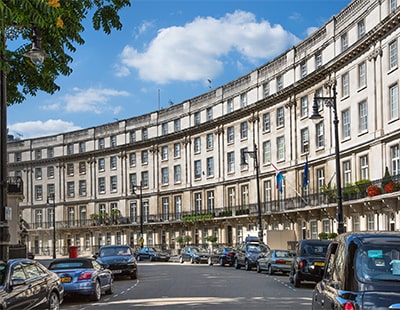Transaction volumes in February were 2.7% lower than a year earlier, 0.3% below the 2017-2019 February average. Under offer numbers had been looking more positive but in February they fell by 7.6% on an annual basis, indicating sales activity may remain low in the short term.
Values, based on average achieved £ per sq ft figures, fell by 7.8% on an annual basis, leaving them 1.1% below where they were 10 years ago.
While demand appears down, the number of new sales instructions in February was 1.0% up on a year earlier and 21.1% above the 2017-2019 February average.
Growing supply and static demand, mean that the stock of homes available to buy across prime London is steadily increasing. At the end of February there were 7.5% more properties for sale than a year earlier, and 25.9% more than at the end of February 2020 – the last month before the pandemic impacted the market.
The longer-term context is that activity in the first two months of the year so far is broadly in line with trends seen in the same months both pre-pandemic and in 2023, but activity has fallen back from levels seen in 2021 and 2022.
Relative to 2017-2019 average levels, under offer numbers are around 10% higher over the year to date, while actual transaction volumes are broadly level. Supply, based on new sales instructions, has risen more quickly but the available stock for sale is only increasing gradually – the market remains relatively balanced.
Price reductions, discounts, and time to sell are telling indicators of the strength of the market.
The latest data suggests some weakening compared to 2021 and 2022, but most metrics are broadly in line with longer-term trends. From 2017-2019, 48% of properties had their asking price reduced prior to being sold. This fell to 41% in 2021 and 2022, with the £5m+ price band lower than this overall average figure. Since the start of 2023 a larger proportion of £5m+ properties are seeing reductions, pushing up the overall average again - to around 50%.
In February, sold properties across prime London achieved, on average, 91.4% of their asking price. This is an improvement on January where the figure dipped below 90% for the first time since early 2019.
Average discounts between 2017-2019 were around 10% so the current level is very much in line with that. Similarly, average time on the market has remained consistent over the past several years. In February the average time from listing to exchange was 166 days across all prime London, compared to 164 days in February last year and 165 days pre-pandemic (2017-2019).
Sales of £5m+ homes in February were up 4.2% on the same month a year earlier, and 25% above the pre-pandemic February average. The number of properties going under offer was 11.5% lower than February 2023, with new £5m+ sales instructions up 8.4% over the same period. This suggests a somewhat mixed picture for top end sales.
As a smaller segment of the overall market, data from a single month can be misleading in this market. Looking at the first two months of the year, the £5m+ price band appears a little weaker than the same point a year ago, with new instructions and price reductions increasing faster than transaction volumes (chart 3) and causing the available stock for sale to grow. There are 26% more £5m+ homes on the market across prime London than a year ago.
The longer-term context shows activity in 2024 to date is significantly higher than pre-pandemic levels. Sales are up more than 40% compared to the 2017-2019 average for the same months (chart 3). By contrast, for the wider market this metric shows no change.
February saw significant improvements in activity across the prime London lettings market, and annual rental growth also increased slightly after four months of falls.
The number of newly agreed lets in February increased by 14.2% compared to a year earlier and was 48.7% below the pre-pandemic February average (table 1). New instructions rose last month by 17.6% on an annual basis, but the figure remained 42.0% below the average 2017-2019 February level. Across prime London there were 48.1% more properties on the market to let at the end of February than a year earlier, but that figure is 25.3% lower than at the end of February 2020.
Annual rental growth across prime London rose slightly in February, to 3.4%, taking values to 26.7% above their 2017-19 average. After four months of falling growth it will interesting to see if rents stabilise as we move through the year.
Data on discounts and reductions suggest that more balance is returning to the lettings market.
The all-time lows for both discounts and price reductions were recorded in Q3 2022, indicating demand significantly outpacing supply. Since then, these metrics have fallen back closer to pre-pandemic levels. The average discount in February was 4.2%, compared to the low of -0.5% (i.e. a premium to asking rent) in September 2022. And 35.1% of properties were reduced before being let, compared to the low of 10.1% in July 2022.
Commenting on the findings, Nick Gregori - Head of Research at LonRes - says: “Once again, the sentiment in the market has been a little more positive than the story told by the latest sales data.
“Agents are telling us they are busy and while we are recording deals being agreed, there seems to be slow progress from offer to exchange which means actual transaction figures remain muted. February saw sales volumes fall by 2.7% compared to a year earlier, standing in line with the longer term average. Stock on the market for sale is growing steadily, with 7.5% more properties available at the end of February than a year ago.
“Values fell again in February, with average achieved prices down by 7.8% on an annual basis. This takes prices back to early 2014 levels. Other metrics such as discounts, reductions and time on the market are all broadly in line with long-term trends, suggesting that the market is operating ‘normally’.
“The most positive sales story remains the £5m+ market, where activity is still significantly ahead of the typical levels recorded from 2017-2019. February saw 4.2% more transactions than the same month last year but new instructions are also increasing, and at a faster rate. 8.4% more sales listings in February than last year on top of the big jump in January means that available stock in this market has grown by 26% over the past 12 months.
“The Budget on 6 March saw some relatively minor tweaks to property taxation – on holiday lets, multiple dwellings relief, and capital gains – plus the abolition of ‘non-dom’ status. This came too late to impact our February data so we will have to wait and see if there is any immediate impact, but it seems unlikely that the sum total of the changes will shift the dial for either supply or demand in the prime London property market.
“The lettings market has been supply-constrained for a long time, but so far this year there are emerging signs of new instructions picking up. Stock on the market has grown by almost 50% compared to a year ago. Annual rental growth appears to have stabilised at around 3.5% after a few months of falls. And our discount and price reduction metrics are moving back towards what would be considered more ‘normal’ levels.”










.png)










Join the conversation
Be the first to comment (please use the comment box below)
Please login to comment